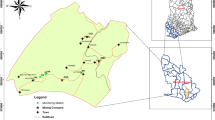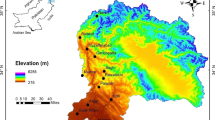Abstract
Waste is a critical issue the modern world is facing, and its management involves many imperative parameters with distinct, negative impacts on the environment. From a fundamental perspective, the primary parameter in waste management is the very generation of waste. SWG standing for solid waste generation is a phenomenon influenced straightforwardly by many factors. This paper introduces an adaptive hybrid model based on the ensemble empirical mode decomposition (EEMD) and AI models to improve the prediction accuracy of monthly municipal SWG. First, to determine the optimum antecedent values of SWG, a partial autocorrelation function is used, and then all input/output variables are decomposed by EEMD to overcome the non-stationary and non-linearity of the time series in the SWG dataset. Data collected from Tehran between 1991 and 2013 helped evaluate the effectiveness of the suggested model. The proposed model was compared with several accredited single models to showcase its performance. Statistical metrics showed that suggested hybrid EEMD–MARS (R = 0.82, NSE = 0.67, RMSE = 9.656, MAE = 7.538) outperformed EEMD–LSSVM and standard LSSVM and MARS models for prediction of SWG. Additionally, the researchers confirmed the reliability of the results based on the uncertainty analysis using a Monte Carlo algorithm, concluding that the EEMD–MARS model had a higher certainty and displayed significant potential in simulating solid waste generation.






Similar content being viewed by others
Data availability
The datasets generated during and/or analysed during the current study are available from the corresponding author on reasonable request.
References
Samal B, Mani S, Madguni O (2020) Open dumping of waste and its impact on our water resources and health—a case of New Delhi India. Springer, Singapore, pp 127–154
Arena U, Mastellone ML, Perugini F (2003) The environmental performance of alternative solid waste management options: a life cycle assessment study. Chem Eng J 96:207–222
El-Fadel M, Findikakis AN, Leckie JO (1997) Environmental impacts of solid waste landfilling. J Environ Manage 50:1–25
Soni U, Roy A, Verma A, Jain V (2019) Forecasting municipal solid waste generation using artificial intelligence models—a case study in India. SN Appl Sci 1:162
Tenodi S, Krčmar D, Agbaba J, Zrnić K, Radenović M, Ubavin D, Dalmacija B (2020) Assessment of the environmental impact of sanitary and unsanitary parts of a municipal solid waste landfill. J Environ Manage 258:110019
Abbasi M, Rastgoo MN, Nakisa B (2019) Monthly and seasonal modeling of municipal waste generation using radial basis function neural network. Environ Prog Sustain Energy 38:e13033
Mozhiarasi V, Raghul R, Speier CJ, Benish Rose PM, Weichgrebe D, Srinivasan SV (2020) Composition analysis of major organic fractions of municipal solid waste generated from Chennai. Sustainable waste management policies and case studies. Springer, Singapore, pp 143–152
Pan A, Yu L, Yang Q (2019) Characteristics and forecasting of municipal solid waste generation in China. Sustainability 11:1433
Duan N, Li D, Wang P, Ma W, Wenga T, Zhong L, Chen G (2020) Comparative study of municipal solid waste disposal in three Chinese representative cities. J Clean Prod 254:120134
Kannangara M, Dua R, Ahmadi L, Bensebaa F (2018) Modeling and prediction of regional municipal solid waste generation and diversion in Canada using machine learning approaches. Waste Manag 74:3–15
Araiza-Aguilar JA, Rojas-Valencia MN, Aguilar-Vera RA (2020) Forecast generation model of municipal solid waste using multiple linear regression. Glob J Environ Sci Manag 6:1–14
Cevik, S, Cakmak R, Altas IH (2017) A day ahead hourly solar radiation forecasting by artificial neural networks: a case study for Trabzon province. pp. 1–6.
Shiri J, Sadraddini AA, Nazemi AH, Kisi O, Marti P, Fard AF, Landeras G (2013) Evaluation of different data management scenarios for estimating daily reference evapotranspiration. Hydrol Res 44:1058–1070
Şahin M (2013) Comparison of modelling ANN and ELM to estimate solar radiation over Turkey using NOAA satellite data. Int J Remote Sen 34:7508–7533
Wei CC (2017) Predictions of surface solar radiation on tilted solar panels using machine learning models: a case study of Tainan city Taiwan. Energies 10:1660
Abbasi M, El Hanandeh A (2016) Forecasting municipal solid waste generation using artificial intelligence modelling approaches. Waste Manag 56:13–22
Azarmi SL, Oladipo AA, Vaziri R, Alipour H (2018) Comparative modelling and artificial neural network inspired prediction ofwaste generation rates of hospitality industry: the case of North Cyprus. Sustain 10:2965
Hunter JM, Maier HR, Gibbs MS, Foale ER, Grosvenor NA, Harders NP, Kikuchi-miller TC (2018) Framework for developing hybrid process-driven, artificial neural network and regression models for salinity prediction in river systems. Hydrol Earth Syst Sci 22:2987–3006
Rezaie-Balf M, Zahmatkesh Z, Kim S (2017) Soft computing techniques for rainfall-runoff simulation: local non–parametric paradigm vs. model classification methods. Water Resour Manag 31(12):3843–3865
Shoaib M, Shamseldin AY, Melville BW (2014) Comparative study of different wavelet based neural network models for rainfall-runoff modeling. J Hydrol 515:47–58
Rezaie-balf M, Naganna SR, Ghaemi A, Deka PC (2017) Wavelet coupled MARS and m5 model tree approaches for groundwater level forecasting. J Hydrol 553:356–373
Najafi A, Masoudi-Nejad A, Imani Fooladi AA, Ghanei M, Nourani MR (2014) Microarray gene expression analysis of the human airway in patients exposed to sulfur mustard. J Recept Signal Transduction 34(4):283–289
Singh VP, Krstanovic PF (1987) A stochastic model for sediment yield using the principle of maximum entropy. Water Resour Res 23:781–793
Krstanovic PF, Singh VPA (1993) Real-time flood forecasting model based on maximum-entropy spectral analysis: I. development. Water Resour Manag 7:109–129
Rocco S, Claudio M (2013) Singular spectrum analysis and forecasting of failure time series. Reliab Eng Syst Saf 114:126–136
Casella G, Fienberg S, Olkin I (2006) Springer Texts in Statistics, Vol. 102. ISBN 9780387781884.
Hassan GE, Youssef ME, Ali MA, Mohamed ZE, Shehata AI (2016) Performance assessment of different day-of-the-year-based models for estimating global solar radiation—case study: Egypt. J Atmos Solar-Terrestrial Phys 149:69–80
Wu Z, Huang NE (2009) Ensemble empirical mode decomposition: a noise-assisted data analysis method. Adv Adapt Data Anal 1(01):1–41
Rezaie-Balf M, Kim S, Fallah H, Alaghmand S (2019) Daily river flow forecasting using ensemble empirical mode decomposition based heuristic regression models: application on the perennial rivers in Iran and South Korea. J Hydrol 572:470–485
Cortes C, Vapnik V (1995) Support-vector networks. Mach Learn 20(3):273–297
Suykens JA, Vandewalle J (1999) Least squares support vector machine classifiers. Neural Process Lett 9(3):293–300
Adnan RM, Yuan X, Kisi O, Yuan Y (2017) Streamflow forecasting using artificial neural network and support vector machine models. Am Sci Res J Eng Technol Sci. 29(1):286–294
Tang W, Li Y, Yu Y, Wang Z, Xu T, Chen J, Li X (2020) Development of models predicting biodegradation rate rating with multiple linear regression and support vector machine algorithms. Chemosphere 253:126666
Mahmoudi N, Orouji H, Fallah-Mehdipour E (2016) Integration of shuffled frog leaping algorithm and support vector regression for prediction of water quality parameters. Water Resour Manage 30(7):2195–2211
Tan Z, De G, Li M, Lin H, Yang S, Huang L, Tan Q (2020) Combined electricity-heat-cooling-gas load forecasting model for integrated energy system based on multi-task learning and least square support vector machine. J Clean Prod 248:119252
Zhang W, Zhang R, Wang W, Zhang F, Goh ATC (2019) A multivariate adaptive regression splines model for determining horizontal wall deflection envelope for braced excavations in clays. Tunn Undergr Space Technol 84:461–471
Zheng G, He X, Zhou H, Yang X, Yu X, Zhao J (2020) Prediction of the tunnel displacement induced by laterally adjacent excavations using multivariate adaptive regression splines. Acta Geotech. https://doi.org/10.1007/s11440-020-00916-w
Adnan RM, Liang Z, Heddam S, Zounemat-Kermani M, Kisi O, Li B (2020) Least square support vector machine and multivariate adaptive regression splines for streamflow prediction in mountainous basin using hydro-meteorological data as inputs. J Hydrol 586:124371
Rezaie-Balf M, Ghaemi A, Jun C, Band SS, Bateni SM (2022) Towards an integrative, spatially-explicit modeling for flash floods susceptibility mapping based on remote sensing and flood inventory data in Southern Caspian Sea Littoral, Iran. Geocarto Int. https://doi.org/10.1080/10106049.2022.2071470
Safari MJS (2019) Decision tree (DT), generalized regression neural network (GR) and multivariate adaptive regression splines (MARS) models for sediment transport in sewer pipes. Water Sci Technol 79(6):1113–1122
Huang NE, Shen Z, Long SR, Wu MC, Shih HH, Zheng Q, Liu HH (1998) The empirical mode decomposition and the Hilbert spectrum for nonlinear and non-stationary time series analysis. Proc R Soc Lond Series A Math Phys Eng Sci. 454(1971):903–995
Huang NE, Wu ML, Qu W, Long SR, Shen SS (2003) Applications of Hilbert-Huang transform to non-stationary financial time series analysis. Appl Stoch Model Bus Ind 19(3):245–268
Lei Y, He Z, Zi Y (2009) Application of the EEMD method to rotor fault diagnosis of rotating machinery. Mech Syst Signal Process 23(4):1327–1338
Antanasijević D, Pocajt V, Perić-Grujić A, Ristić M (2014) Modelling of dissolved oxygen in the Danube River using artificial neural networks and Monte Carlo Simulation uncertainty analysis. J Hydrol 519:1895–1907
Noori R, Hoshyaripour G, Ashrafi K, Araab BN (2010) Uncertainty analysis of developed ANN and ANFIS models in prediction of carbon monoxide daily concentration. Atmos Environ 44(4):476–482
Gao M, Yin L, Ning J (2018) Artificial neural network model for ozone concentration estimation and Monte Carlo analysis. Atmos Environ 184:129–139
Acknowledgements
The authors are grateful to the learned reviewers and their critical comments. Their comments have guided the authors to improve the manuscript.
Author information
Authors and Affiliations
Corresponding author
Additional information
Publisher's Note
Springer Nature remains neutral with regard to jurisdictional claims in published maps and institutional affiliations.
Rights and permissions
Springer Nature or its licensor (e.g. a society or other partner) holds exclusive rights to this article under a publishing agreement with the author(s) or other rightsholder(s); author self-archiving of the accepted manuscript version of this article is solely governed by the terms of such publishing agreement and applicable law.
About this article
Cite this article
Ghanbari, F., Kamalan, H. & Sarraf, A. Predicting solid waste generation based on the ensemble artificial intelligence models under uncertainty analysis. J Mater Cycles Waste Manag 25, 920–930 (2023). https://doi.org/10.1007/s10163-023-01589-9
Received:
Accepted:
Published:
Issue Date:
DOI: https://doi.org/10.1007/s10163-023-01589-9




